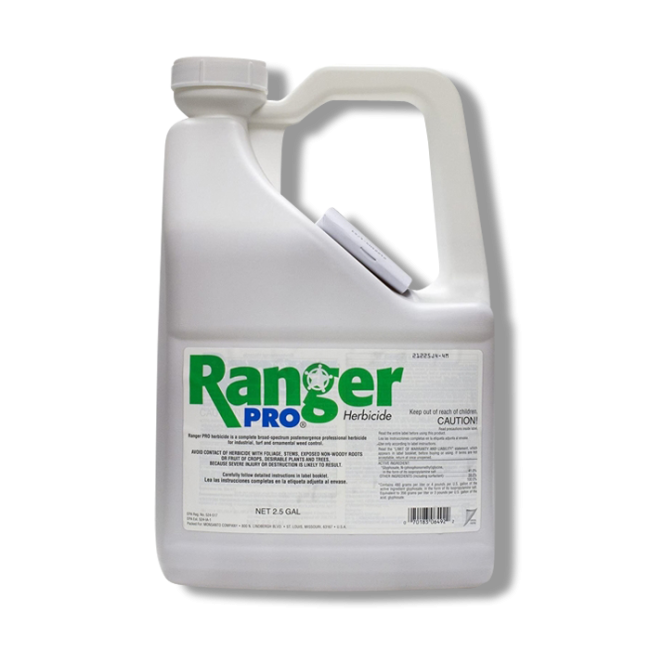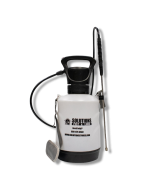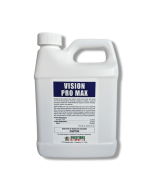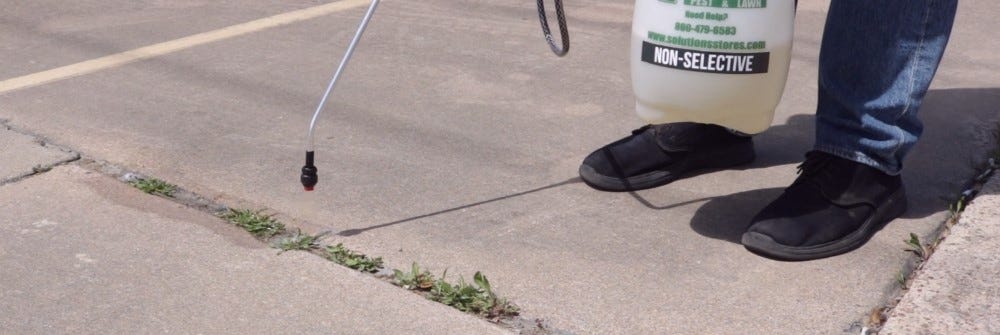Gain access to personalized product screening, the best pricing, rewards, and more!






application2
Ranger Pro Weed Killer
Ranger Pro is a post-emergent herbicide that successfully controls many weeds and brush. It contains the active ingredient Glyphosate, the same as Round Up Pro, and is excellent for residential and commercial weed control. This weed killer is economically priced and easy to use.
12/16/25
Ranger Pro Herbicide, manufactured by Monsanto, is a non-selective post-emergent Glyphosate herbicide. Its active ingredient, Glyphosate, shares the same formula as RoundUp Pro but is more cost-effective.
This Glyphosate herbicide has a water-soluble liquid formulation that can kill most grasses and is built-in with a surfactant, so adding additional surfactant is unnecessary to control weeds. However, you can still optionally include other surfactants.
Ranger Pro Weed Killer is a systemic herbicide with no soil activity, meaning it is absorbed by the target weed either from the root system or foliage contact and moves through the entire plant, killing it. This Glyphosate herbicide doesn’t spread to the ground or kill neighboring plants that are not contacted by the product.
Tools Needed
To apply the Ranger Pro Glyphosate Herbicide, you will need either a backpack sprayer, a handheld pump sprayer, or a professional skid sprayer for large-volume applications.
How to Use
- Step 1: To determine how much Ranger Pro Herbicide you need, you must first determine the size of the target area. To do this, measure the length and width of the treatment area in feet, then multiply them together (length X width = square footage). For general spray-to-wet applications for annual weeds and perennial weeds, the mix ratio will be 0.5 to 10 percent solution of water-soluble liquid Ranger Pro at a rate of 2/3 fl. oz. to 13 fl. oz. per gallon of water to cover 1,000 sq. ft. Use the higher rate for weeds over 6 inches tall. Check the label for specific rates depending on the weed or root system you're trying to control.
- Step 2: Fill the spray tank with the required amount of water. Near the end of filling the tank, add the correct amount of the water-soluble liquid Glyphosate herbicide. If you are using a backpack or handheld pump-up sprayer, it is suggested that the labeled amount of Ranger Pro Herbicide be mixed with water in a larger container and then filled with the sprayer with the mixed Glyphosate solution.
- Step 3: Apply the solution to targeted weeds at low pressure, spraying to wet but before the point of runoff. Use a fan nozzle spray setting for uniform and thorough foliage contact coverage. This will not kill neighboring plants.
Where to Use
Ranger Pro Weed Killer is formulated for use in outdoor areas such as recreational areas, parks, farms, croplands, apartment complexes, Christmas tree farms, ditch banks, ornamental plant nurseries, golf courses, lumber yards, warehouses, schools, storage areas, railroads, constructions sites before building or laying asphalt, conservation properties, and other areas.
When to Use
Apply the Ranger Pro Glyphosate herbicide to control target weeds during daylight hours when the weather is sunny, warm, and calm so that the chemicals move through the weeds faster. It is also beneficial to make applications when the plants are young and actively growing.
Do not treat weeds with the Ranger Pro if there is drought, disease, or insect damage, as this may make weed control less effective by allowing the product to soak into the foliage.
Spray the Glyphosate herbicide on calm days when wind speeds are low to minimize accidental spray drift.
Safety Information
Ranger Pro Weed Killer is safe to use around children or pets when applied according to the product label instructions. Always wear the proper personal protective equipment when mixing or applying this Glyphosate herbicide.
Keep people and pets off-treated areas until the spray solution has dried.
Special Considerations
Remember that Ranger Pro is a non-selective, post-emergent herbicide and will negatively affect or kill desired plants if foliar contact is made. Always be mindful of spray drift so you do not accidentally spray wanted turf grass or other desirable plants with Glyphosate herbicide.
| Restricted Use | No |
|---|---|
| Shipping Restrictions | MN |
| Availability | Online |
| Signal Word | CAUTION |
| Keith's Pro Tip | "When spraying large areas with Ranger Pro, it's a good idea to use an indicator dye to not only keep track of your spraying to avoid over-application but also to help you see any spray drift." |
| Target Pests Multi | Alfalfa, Alligatorweed, Anise Fennel, Annual Bluegrass, Annual Fleabane, Annual Sowthistle, Annual Spurge, Artichoke Thistle, Bahiagrass, Barnyardgrass, Bentgrass, Bermudagrass, Bittercress, Black Nightshade, Blue Mustard, Bracken Fern, Bristly Starbur, Broadleaf Signalgrass, Browntop Panicum, Bulbous Bluegrass, Buttercup, Canada Thistle, Carolina Foxtail, Carolina Geranium, Castorbean, Cattail, Cheatgrass, Cheeseweed, Chervil, Chickweed, Cocklebur, Cogongrass, Common Groundsel, Common Milkweed, Common Mullein, Common Purslane, Common Ragweed, Common Rye, Corn, Corn Speedwell, Corn Volunteer, Coyote Brush, Crabgrass, Curly Dock, Dallisgrass, Dandelion, Deerweed, Downy Brome, Dwarfdandelion, Eastern Mannagrass, Eclipta, European Beachgrass, Fall Panicum, False Dandelion, Fescue, Fiddleneck, Field Bindweed, Field Pennycress, Field Sandbur, Filaree, Fivehook Bassia, Florida Beggarweed, Florida Pusley, Foxtail, German Ivy, Giant Ragweed, Goosegrass, Guineagrass, Hairy Fleabane, Hemp Dogbane, Hemp Sesbania, Henbit, Honeysuckle, Horsenettle, Horseradish, Horseweed/Marestail, Iceplant, Itchgrass, Japanese Brome, Jerusalem Artichoke, Johnsongrass, Jointed Goatgrass, Junglerice, Kentucky Bluegrass, Kikuyugrass, Knapweed, Knotgrass, Knotweed, Kochia, Kudzu, Ladysthumb, Lambsquarters, Lantana, Leafy Spurge, Lespedeza, Little Barley, London Rocket, Mayweed, Medusahead, Milkweed, Milo, Morningglory, Multiflora Rose, Musk Thistle, Napier Grass, Oats, Orchardgrass, Pampasgrass, Paragrass, Pennsylvania Smartweed, Perennial Pepperweed, Perennial Ryegrass, Phragmites, Pigweed, Poison Hemlock, Poison Ivy, Poison Oak, Prickly Lettuce, Prickly Sida, Prostrate Spurge, Puncture Vine, Purple Nutsedge, Purslane Speedwell, Quackgrass, Quaking Aspen, Red Clover, Red Rice, Redroot Pigweed, Redvine, Reed Canarygrass, Rough Fleabane, Russian Thistle, Rye, Ryegrass, Seedling Johnsongrass, Shattercane, Shepherdspurse, Sicklepod, Silverleaf Nightshade, Smallseed Falseflax, Smartweed, Smooth Bromegrass, Smutgrass, Spanishneedles, Spotted Spurge, Sprangletop, Spurred Anoda, Stinkgrass, Sunflower, Swamp Smartweed, Tall Fescue, Tansy Mustard, Teaweed, Texas Blueweed, Texas Panicum, Tickseed Coreopsis Plains, Timothy, Torpedograss, Trumpet Creeper, Tumble Mustard, Umbrella Spurry, Vaseygrass, Velvetgrass, Velvetleaf, Virginia Copperleaf, Virginia Creeper, Virginia Pepperweed, Western Wheatgrass, Wheat, White Clover, Wild Mustard, Wild Oats, Wild Sweet Potato, Willow, Wirestem Muhly, Witchgrass, Woolly Cupgrass, Woollyleaf Bursage, Yellow Rocket, Yellow Starthistle, Yellow_Nutsedge, Alder, American Hornbean, Ash, Barley, Beech, Birch, Bitter Cherry, Black Cherry, Black Gum, Black Locust, Black Oak, Black Sage, Blackberry, Brazilian Peppertree, California Buckwheat, California Sagebrush, California Yerba Santa, Cascara, Catsclaw, Ceanothus, Chamise, Chinese Tallowtree, Dogfennel, Dogwood, Eastern Redbud, Elderberry, Elm, Eucalyptus, French Broom, Gorse, Hasardia, Hawthorn, Hazel, Hickory, Madrone Resprouts, Manzanita, Monkey Flower, Northern Pine Oak, Persimmon, Pin Cherry, Pine, Poison Sumac, Post Oak, Red Maple, Salmonberry, Salt Cedar, Sassafras, Scotch Broom, Scrub Oak, Smooth Sumac, Sourwood, Southern Red Oak, Southern Waxmyrtle, Sugar Maple, Sugarbush Sumac, Sumac, Sweet Gum, Swordfern, Tan Oaks Resprouts, Thimbleberry, Tobacco Tree, Toyon, Vine Maple, White Oak, White Sage, Winged Sumac, Yellow Poplar |
| Time to Kill | Effects are visible on most annual weeds within 2 to 4 days, but on most perennial weeds may not occur for 7 days or more. |
| Chemical Type | Herbicide |
| Formulation | Suspended Concentrate |
| Application Methods | Broadcast Spray, Spot Treatment |
| Product Drawbacks | Ranger Pro Herbicide is a non-selective herbicide so you have to be very careful when spraying it in areas where desired vegetation is in close proximity. |
| Active Ingredient | Glyphosate - 41% (same active ingredient as Roundup) |
| Application Equipment | Backpack Sprayer, Pump Sprayer, Spray Rig |
| Mix Rate | Ranger Pro mix rates vary depending on percentage ratios of .5%, 1%, 1.5%, 2%, 5% and 10%. Ranger Pro can be mixed between 2/3 oz. to 13 oz. per gallon of water depending on the desired dilution ratio. For more specific application rates please refer to the label. |
| Use Sites | Outdoors |
| Yield | A 2.5 Gallon Jug of Ranger Pro Herbicide at an average rate of 2 oz. per gallon, can treat up to 160,000 sq. ft. of area. |
| EPA Registration No. | 524-517 |
| Shelf Life | Ranger Pro Herbicide will last 2 to 3 years in storage if kept in a cool, dry area. |
| Comparable Products | Glyphosate 4 Weed Killer, Eraser 41% Glyphosate, Roundup Pro, Gly Pho-Sel Pro |
| Children or pets? | No |
| Property Characteristics | None |
| Availability | Online |
| Restricted Use | No |
| Brand | BAYER CROP SCIENCE |
| Keith's Pro Tips | "When spraying large areas with Ranger Pro, it's a good idea to use an indicator dye to not only keep track of your spraying to avoid over-application but also to help you see any spray drift." |
| Product Drawbacks | Ranger Pro Herbicide is a non-selective herbicide so you have to be very careful when spraying it in areas where desired vegetation is in close proximity. |
| Target Pests | Ranger Pro Herbicide can control annual weeds, Perennial weeds, Brush Weeds, Tree Seedlings. Alder, American Hornbeam, Annual Bluegrass, Annual Fleabane, Annual Sowthistle, Annual Spurge, Artichoke Thistle, Ash, Bahiagrass, Barley, Barnyardgrass, Bearclover, Beech, Bentgrass, Bermudagrass, Birch, Bitter Cherry, Bittercress, Black Cherry, Black Locust, Black Nightshade, Black Oak, Black Sage, Blackberry, Blackgum, Blue Mustard, Blue Vervain, Bracken, Brackenfern, Brazilian Peppertree, Bristly Starbur, Broadleaf Signalgrass, Bromegrass, Broomsedge, Broomsedge Raspberry, Browntop Pamicum, Bulbous Bluegrass, Buttercup, California Buckwheat, California Sage Brush, California Yerba Santa, Canada Thistle, Canafa Thistle, Carolina Foxtail, Cascara, Castorbean, Catsclaw, Cattail, Ceanothus, Chamise, Cheatgrass, Cheeseweed, Chervil, Chickweed, Chinese Tallowtree, Cocklebur, Cogongrass, Common Groundsel, Common Milkweed, Common Mullein, Common Purslane, Common Ragweed, Common Rye, Corn, Corn Speedwell, Coyotebrush, Crabgrass, Crolina Geranium, Curly Dock, Dallisgrass, Deerweed, Dewberry, Dogfennel, Dogwood, Downy Brome, Dwarfdandelion, Eastern Mannagrass, Eastern Redbud, Eclipta, Elderberry, Elm, Eucalyptus, Fall Panicum, Falsedandelion, Fescue, Fiddleneck, Field Bindweed, Field Pennycress, Field Sandbur, Filaree, Fivehook Bassia, Florida Beggarweed, Florida Pusley, Foxtail, French Broom, German Ivy, Giant Ragweed, Giant Reed, Goosegrass, Gorse, Grain Sorghum, Guineagrass, Hairy Fleabane, Hasardia, Hawthorn, Hazel, Hemp Dogbane, Hemp Sesbania, Henbit, Hickory, Honeysuckle, Hophornbeam Copperleaf, Horsenettle, Horseradish, Horseweed, Iceplant, Itchgrass, Japanese Brome, Johnsongrass, Johnsongrass seedling, Jointed Goatgrass, Junglerice, Kentucky Bluegrass, Kikuyugrass, Knapweed, Knotweed, Kochia, Kudzu, Ladysthumb, Lamb's-Quarters, Lantana, Laurel Sumac, Leafy Spurge, Lespedeza, Little Barley, London Rocket, Madrone Resprouts, Mandzanita, Marestail, Mayweed, Medusahead, Milkweed, Monkey Flower, Morningglory, Multiflora Rose, Musk Thistle, Napiergrass, Oats, Orchardgrass, Pampasgrass, Paragrass, Pennsylvania Smartweed, Perennial Pepperweed, Perennial Ryegrass, Persimmon, Phragmites, Pigweed, Pin Cherry, Pine, Plains Coreopis, Poison Hemlock, Poison Ivy, Poison Oak, Poison Sumac, Poorjoe, Post Oak, Prickly Lettuce, Prickly Sida, Puncturevine, Purple Nutsedge, Purslane Speedwell, Quackgrass, Quaking Aspen, Red Clover, Red Maple, Red Rice, Redroot Pigweed, Redvine, Reed Canarygrass, Rough Fleabane, Russian Olive, Russian Thistle, Rye, Ryegrass, Salmonberry, Saltcedar, Sassafras, Scotch Broom, Scrub Oak, Shattercane, Shepherd's-Purse, Sicklepod, Sicklepot, Silver Bluestem, Silverleaf Nightshade, Smallseed Falseflax, smartweed, Smooth Bromegrass, Smooth Sumac, Smutgrass, Sourwood, Southern Red Oak, Southern Waxmyrtle, Spanishneedles, Spotted Spurge, Sprangletop, Spurge Prostrate, Spurred Anoda, Stinkgrass, Sugar Maple, Sugarbrush Sumac, Sugarbush Sumac, Sumac, Sunflower, Sunflowers, Swamp Smartweed, Sweetgum, Swordfern, Tall Fescue, Tanoak Resprouts, Tansy Mustard, Teaweed, Texas Blueweed, Texas Panicum, Texas Paniicum, Thimbleberry, Tickswwd, Timothy, Torpedograss, Toyon, Tree Tobacco, Trumpet, Trumpetcreeper, Tumble Mustard, Umbrella Spurry, Vaseygrass, Velvetgrass, Velvetleaf, Vine Maple, Virginia Copperleaf, Virginia Creeper, Virginia Pepperweed, Volunteer Corn, Western Wheatgrass, Wheat, White Clover, White Oak, White Sage, Wild Mustard, Wild Oats, Wild Sweet Potato, Willow, Winged Sumac, wirestem Muhly, Witchgrass, Woolly Cupgrass, Woolly-Leaf Bursage, Yellow Nutsedge, Yellow Poplar, and Yellow Rocket. Please refer to the product label for a complete list of target weed species. |
| Application Equipment | Backpack Sprayer, Pump Sprayer, Spray Rig |
| Application Methods | Broadcast Spray, Spot Treatment |
| Active Ingredient | Glyphosate - 41% (same active ingredient as Roundup) |
| Product Type | Herbicide |
| Formulation | Suspended Concentrate |
| Application Rate | Ranger Pro mix rates vary depending on percentage ratios of .5%, 1%, 1.5%, 2%, 5% and 10%. Ranger Pro can be mixed between 2/3 oz. to 13 oz. per gallon of water depending on the desired dilution ratio. For more specific application rates please refer to the label. |
| Shelf Life | Ranger Pro Herbicide will last 2 to 3 years in storage if kept in a cool, dry area. |
| Yield | A 2.5 Gallon Jug of Ranger Pro Herbicide at an average rate of 2 oz. per gallon, can treat up to 160,000 sq. ft. of area. |
| Use Sites | Outdoors |
| Time to Kill | Effects are visible on most annual weeds within 2 to 4 days, but on most perennial weeds may not occur for 7 days or more. |
| Comparable Products | Glyphosate 4 Weed Killer, Eraser 41% Glyphosate, Roundup Pro, Gly Pho-Sel Pro |
| Use Caution With | Bentgrass, Bermudagrass, Kentucky Bluegrass, Fescue, Fine, Fescue, Tall, Kikuyugrass, Ryegrass, St Augustine, Zoysiagrass |
| EPA Registration # | 524-517 |
*Price does not include freight. We guarantee our rate plus shipping will be less than anyone else's price.











